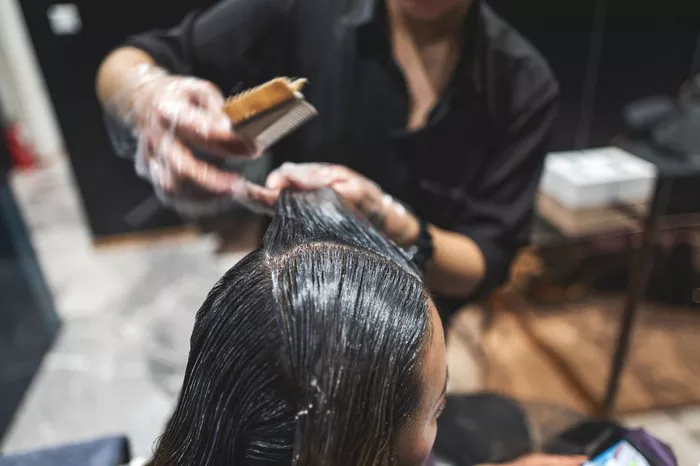Hair is more than just a style statement; it’s a complex structure made mostly of a protein called keratin. Imagine your hair as a rope woven from tiny protein fibers. This “rope” has three layers:
- Cuticle: The outer layer, like roof shingles, protects the inner layers.
- Cortex: The middle layer, holding keratin and moisture, giving hair strength and elasticity.
- Medulla: The innermost layer, less relevant for treatment purposes.
Daily styling, coloring, or environmental factors (sun, wind) damage the cuticle, weakening the cortex. This leads to breakage, frizz, and dullness. Protein treatments help rebuild this structure, restoring hair’s health.
What Is a Protein Treatment?
A protein treatment is a deep-conditioning process that replenishes lost proteins in hair. Think of it as “filling cracks” in damaged areas. These treatments:
- Repair broken keratin bonds.
- Strengthen the hair shaft.
- Restore elasticity and shine.
They come in various forms—creams, masks, or salon services—and suit most hair types, especially damaged or chemically treated hair.
Types of Protein Treatments
Hydrolyzed Protein Treatments
-
- Proteins (like wheat, soy, or keratin) are broken into tiny particles to penetrate hair.
- How They Work: Bind to damaged areas, smoothing the cuticle.
- Best For: Mild damage or regular maintenance.
Keratin Treatments (Brazilian Blowouts)
-
- Intensive formulas filled with keratin.
- How They Work: Coat hair, sealing gaps and reducing frizz. Results last 2–5 months.
- Best For: Severe damage or frizz control.
Reconstructive Treatments
-
- Combine proteins with strengthening ingredients (e.g., amino acids).
- How They Work: Rebuild the cortex for long-term repair.
- Best For: Brittle, over-processed hair.
Protein-Enriched Products
-
- Shampoos, conditioners, or leave-ins with low protein doses.
- Best For: Weekly maintenance.
DIY Protein Treatments
-
- Ingredients: Eggs (rich in protein), yogurt, or avocado.
- Example Mask: 1 egg + 2 tbsp yogurt + 1 tbsp honey. Apply for 20 minutes, rinse with cool water.
- Caution: DIY treatments offer mild benefits but lack the potency of professional products.
Benefits of Protein Treatments
- Strengthens Hair: Repairs weak spots, reducing breakage.
- Improves Elasticity: Hair stretches without snapping.
- Adds Shine: Smooth cuticles reflect light better.
- Balances Moisture: Works with hydrating products to prevent dryness.
- Protects Against Damage: Acts as a shield against heat/chemicals.
How to Use Protein Treatments
Frequency:
-
- Mild Damage: Every 4–6 weeks.
- Severe Damage: Every 2 weeks (temporarily).
- Overuse Risk: Protein overload (stiff, brittle hair).
Application Steps:
-
- Wash hair with clarifying shampoo.
- Apply treatment from roots to ends.
- Leave for 10–30 minutes (follow product instructions).
- Rinse thoroughly and follow with a moisturizing conditioner.
Moisture-Protein Balance:
-
- Protein rebuilds structure; moisture adds flexibility.
- If hair feels stiff, alternate with deep conditioning.
Signs Your Hair Needs Protein
- Mushy or Limp Hair: Loses shape when wet.
- High Porosity: Absorbs water quickly but dries fast.
- Excessive Shedding: More breakage than usual.
- After Chemical Services: Coloring, bleaching, or perming.
Risks and Precautions
Protein Overload Symptoms:
- Stiff, straw-like texture.
- Increased breakage.
Fix It: Pause protein use; focus on moisturizing masks.
Allergies: Patch-test products with wheat/soy proteins if sensitive.
Conclusion
Protein treatments are a powerful tool for restoring damaged hair. By understanding your hair’s needs—whether through DIY masks or salon services—you can maintain strength and shine. Always consult a stylist for personalized advice, and remember: balance protein with moisture for healthy, resilient hair.
Related topics:
Can Protein Treatments Repair Damaged Hair
5 Best Protein Treatment for Black Hair: A Comprehensive Guide
5 Best Protein Treatments for Stronger, Healthier Hair


